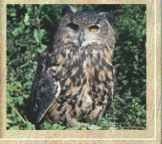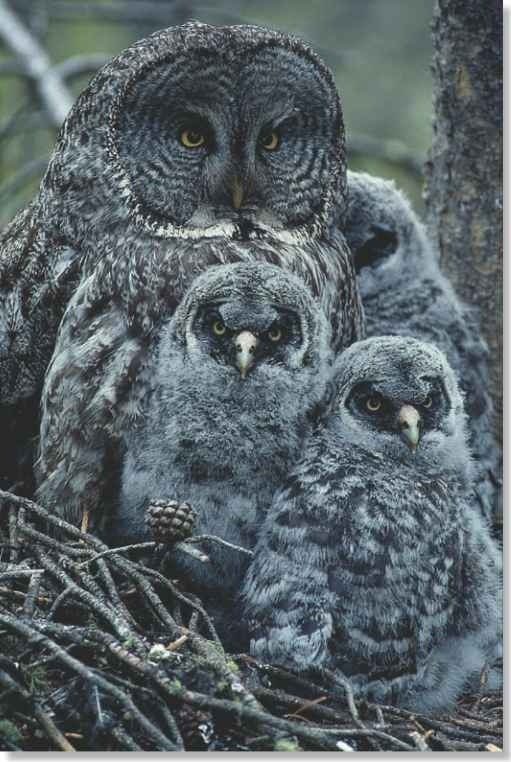ORDER
Strigiform.es
FAMILY
Strigidae
GENUS & SPECIES
KEY FEATURES
• Feeds mainly on voles and other small rodents
• Stealthy in attack, its dense plumage and soft flight feathers allow it to swoop silently on prey
• Able to hear the movements of a vole many yards away under a blanket of snow
• Largest of the forest owls, it is notable for the aggression with which it defends its nest
WHERE IN THE WORLD?
Coniferous and mixed forests at high northern latitudes; in North America, ranges from central Alaska to Ontario and into Montana; it also occurs from Scandinavia east to Siberia
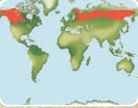
LIFECYCLE
Vocal in courtship and defense of its nest, the great gray owl maintains a deathly silence when cruising through cold, dark northern forests in pursuit of rodent prey.
Habitat
In North America the great gray owl lives in tracts of mature coniferous forest. It haunts a similar habitat across the Eurasian taiga — the vast boreal forest belt that extends from Finland east to Siberia’s Pacific coast.
These dark forests are bitterly cold — more so on occasion than the open, icy tundra to the north — and are blanketed in deep snow for six months of the year
The owl prefers to hunt in the open — particularly in the summer, when breezes bring relief from the mosquitoes, blackflies and midges that fill the air
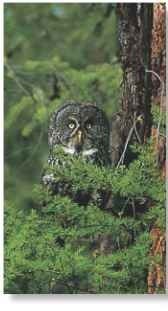
a Land of larches Remote northern forests are home to this huge owl.
Breeding
In early spring, the male uses a deep, booming call to attract a mate. A breeding pair usually adopts an unused stick nest of a goshawk or buzzard.The female owl lays her white eggs — usually up to six — at two-day intervals. She sits throughout the incubation, and it falls to the male to fetch food for them both.
As a result of the staggered laying process, the chicks hatch over several days. During seasons when food is scarce, the eldest and strongest owlet eats at the expense of younger siblings, which quickly starve.This brood reduction, though seemingly cruel, ensures that at least some young have the best possible start in life.
Owlets leave the nest after three weeks, but depend on their parents for a couple of months before dispersing.
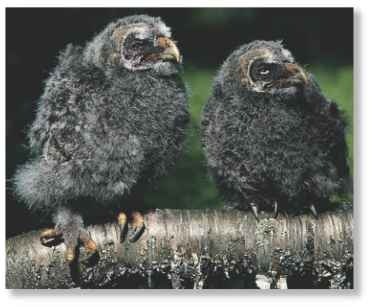
The odd couple Owlets are able fliers within nine weeks or so.
Food & hunting
The great gray owl prefers to hunt in the half-light of dawn and dusk that prevails for much of the day in high latitudes. It sits for long periods on a favorite perch, although it occasionally soars over its territory to search for prey. With its acute hearing, the owl can not only hear a vole scurrying through its snow tunnels but also pinpoint its exact location. In flight, the owl can thread its way adroitly through the branches and dive feet first into a snowdrift.
The owl’s maneuverability is remarkable for a bird of its size. In addition, the edges of its flight feathers have small,
comblike structures that mask the sound of air passing over the wing, muffling the bird’s approach.
► Patient customer The owl perches to listen for prey movements.
going undercover
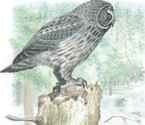
Scanning…
In a silent clearing, a great gray owl listens from its perch. It tilts its head to place the sound of faint scratching.
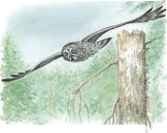
Investigating…
The owl takes to the air. It is relatively light in relation to its wing surface area.-which accounts for its relaxed, heronlike flight.
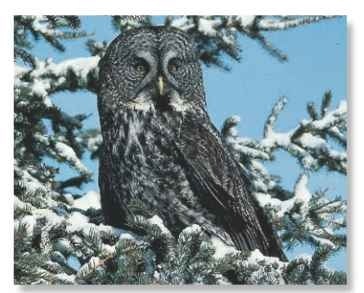
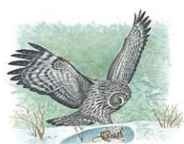
Breakthrough…
Hovering briefly above the source of sound, the owl strikes blindly through the upper layer of snow and sinks its talons into the vole.
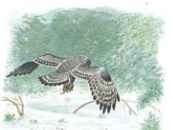
Catch and carry
With the prey gripped in its-vicelike talons, the owl crosses the clearing to its perch and enjoys its meal.
The great gray owl can detect prey as far away as 300′, and strike accurately up to 18″ beneath the surface of the snow.
When guarding its nest, the owl utters a menacing, piglike grunt. It attacks any humans who come too close, and has plucked out eyes and broken cheekbones.
Conservation
Fur trappers routinely kill the owl because it is believed to hunt fur-bearing animals, such as the mink.This makes little impact on the species, whose habitat remains vast and remote. However, a long-term threat is posed by peat-cutting, logging and mining in the Eurasian taiga.
Behavior
The great gray owl remains solitary outside the breeding season, although birds may gather in relatively large numbers where vole populations are high. It is frequently nomadic in winter, but not through choice: temperatures in the Siberian taiga can plummet to -76°F, and the owl must occasionally seek milder conditions at lower latitudes. Periodical crashes in localized vole populations also force the owl to abandon its territory and fly hundreds of miles to a food-rich area. At such times the owl may stray into farmland or settlements, where it faces unfamiliar dangers. It defends itself fearlessly from intruders, snapping its bill and even swooping in attack.
Early warning
Keen hearing alerts the owl to intruders.
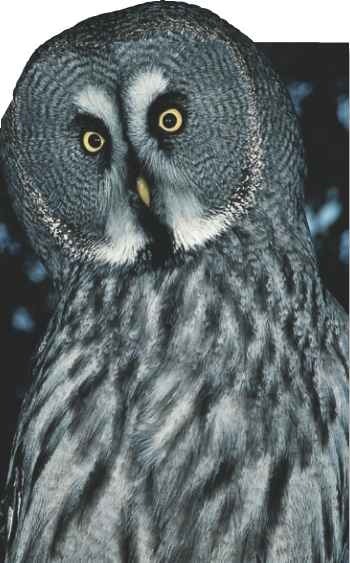
Profile
Great Gray Owl
In its frequently snowbound habitat, the great gray owl relies on streaked gray plumage for concealment and on finely tuned hearing to detect prey.

Creature comparisons
The African wood owl (woodfordii), found south of the Sahara in Africa, is considerably smaller than the great gray owl at 14″. It has dark-brown eyes, spotted brown upperparts and barred lower underparts. Individuals vary in color more than the great gray owl, sporting a range from rust to dark brown. Unlike its mainly vole-eating cousin, the wood owl has a varied diet, taking snakes, small birds, shrews and rodents. It can even catch insects in flight. Like the great gray owl, the wood owl relies on its hearing when hunting and has a large, dished face that helps to direct sound into the ears.
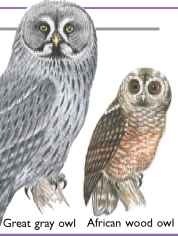
| STATISTICS Weight Male 1-2 lbs.; female 2-4 lbs. |
|
| Length | 26-34″ |
| Wingspan | 4-5′ |
| Sexual Maturity; | 2 years |
| Breeding Season | March-May |
| Number of Eggs | Up to 9; usually 3-6 |
| Incubation Period | 28-30 days |
| Fledging Period | 60-65 days |
| Breeding E Interval | 1 year |
| Typical Diet | Small rodents, shrews, small birds |
| Lifespan | 7-10 years |
RELATED SPECIES
• The great gray owl is 1 of 13 species in genus Strix. The owl family, Strigidae, ranges in ; size from the elf owl, Micrathene whitneyi, to one of the heaviest owls, the northern eagle owl, Bubo bubo (below).
